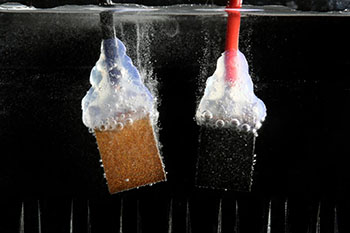
Electrical current provided by perovskite solar cells causes water to split into oxygen and hydrogen at catalytic electrodes. (Photo: EPFL/LPI/Alain Herzog)
Photovoltaic (PV) technology has taken huge leaps in recent years—but storing energy captured from the sun in usable fuel remains a hurdle to be cleared if solar is ever to prove a realistic alternative to fossil fuels at current scale. An international team of scientists now reports that it has pressed an up-and-coming PV material, perovskite, into service to split water and create low-cost, high-density hydrogen fuel (Science, doi: 10.1126/science.1258307). While the system still has a number of significant kinks to work out—most notably in the stability of the perovskite cells—it opens a promising new direction toward a solar-fueled future.
Perovskite PVs have already garnered attention for their rapid gains in reported conversion efficiency, and their low potential production costs at scale, using common Earth materials. To see if those qualities could help drive a system for efficient artificial photosynthesis, Jingshan Luo and colleagues at the Laboratory of Photonics and Interfaces at EPFL, Switzerland, along with scientists in Singapore and Korea, set up two state-of-the-art perovskite solar cells, with a measured conversion efficiency of 17.3 percent, next to each other in series, to achieve the minimum 1.7 V potential difference needed for practical water splitting.
They then tied the perovskite cell complex to nickel-foam electrodes coated with a nickel-iron layered double hydroxide catalyst, which were immersed in water. The team purposely sought catalysts that, like the perovskite cells, could be made with abundant Earth materials, and avoided rare-metal catalysts, such as platinum, that commonly figure into water-splitting experiments.
When the system was run, the scientists confirmed using gas chromatography that hydrogen and oxygen were bubbling out in the expected two-to-one ratio. The measured current density was 10 mA/cm2, which the team says corresponds to a 12.3 percent solar-to-hydrogen efficiency. While that efficiency is already near the top end of what’s been achieved in other systems using costlier materials, the team believes that efficiencies could rise to as high as 15 percent given the rapid development of perovskite cells.
Some significant challenges remain to making such a system practical at scale—especially the instability of the perovskite cells themselves, in which the photocurrent degrades after only a few hours. Nonetheless, the work does drop perovskite cells squarely in the race toward cheap, workable conversion of sunlight into storable hydrogen fuel, thereby potentially addressing one of the biggest present drawbacks of solar energy. “Once you have hydrogen,” says Michael Grätzel, the leader of the EPFL photonics lab, “you store it in a bottle and you can do with it whatever you want to, whenever you want it.”
